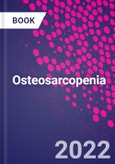Falls, fractures, frailty, osteoporosis and sarcopenia are highly prevalent in older persons. While the concept of osteosarcopenia is new, it is a rapidly evolving and cross-disciplinary problem. Prevention and treatment are challenging and a combined therapeutic approach is needed. Osteosarcopenia provides evidence-based information on how to prevent and treat these conditions at multiple settings, including multiple illustrations, care pathways and tips to easily understand the pathophysiology, diagnostic methods and therapeutic approach to these conditions. This work evaluates the potential for a link between osteoporosis, sarcopenia and obesity.
Please Note: This is an On Demand product, delivery may take up to 11 working days after payment has been received.
Table of Contents
1. Muscle and bone biology Similarities and differences 2. Mesenchymal stem cells as regulators of bone, muscle and fat formation 3. Age-related changes in muscle, fat and bone: Their impact on metabolism and function. 4. Cross-talk between muscle, fat and bone 5. Falls and fracture risk assessment The role of osteoporosis, obesity and sarcopenia. 6. Good and bad fat in osteosarcopenia 7. Glucose metabolism and osteosarcopenia 8. Diagnosis of osteosarcopenia Clinical 9. Diagnosis of osteosarcopenia Imaging 10. Genetics of osteosarcopenia 11. Non-pharmacological interventions for osteosarcopenia 12. Pharmacological treatments of osteosarcopenia 13. Social impact of osteosarcopenia 14. Models of care for falls and fracture prevention








